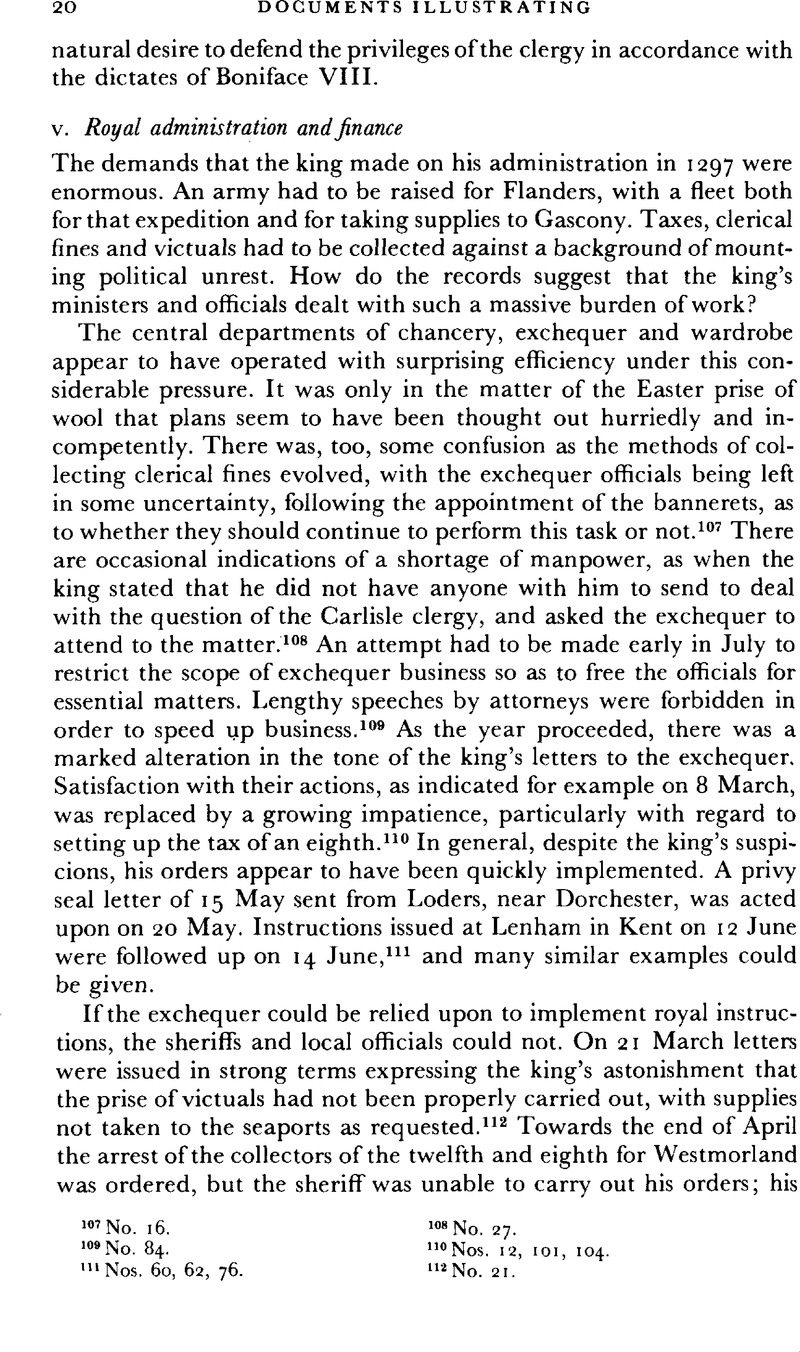No CrossRef data available.
Article contents
v. Royal administration and finance
Published online by Cambridge University Press: 21 December 2009
Abstract

- Type
- Introduction
- Information
- Camden Fourth Series , Volume 24: Documents Illustrating the Crisis of 1297–98 in England , July 1980 , pp. 20 - 25
- Copyright
- Copyright © Royal Historical Society 1980
References
107 No. 16.
108 No. 27.
109 No. 84.
110 Nos. 12, 101, 104.
111 Nos. 60, 62, 76.
112 No. 21.
113 No. 47.
114 No. 94.
115 Rothwell, H., ‘The Disgrace of Richard of Louth, 1297’, E.H.R., xlviii (1933), 259–64CrossRefGoogle Scholar; infra, nos. 11, 75.
116 A Lincolnshire Assize Roll for 1298; a full list of the surviving rolls from this enquiry is given by Rothwell, , ‘The Disgrace of Richard of Louth’, 261.Google Scholar
117 Statutes of the Realm (London, 1810), i, 213Google ScholarPubMed; E 368/69, m. 71.
118 Guisborough, p. 290Google Scholar. They did not co-operate, however, over the payment of clerical fines in the liberties of the Welsh Marches.
119 E 159/70, m. 88d; Fryde, , ‘Financial Resources of Edward I in the Netherlands’, 1182, n. 6.Google Scholar
120 No. 54. Craucombe had been sent as a royal envoy to Rome in 1294 (C.P.R., 1292–1301, p. 105).Google Scholar
121 No. 88.
122 No. 98; Treaty Rolls, i, 134.Google Scholar
123 The figures of wardrobe expenditure are conveniently summarized in Tout, T. F., Chapters in the Administrative History of Medieval England, vi (Manchester, 1933), 80–1Google Scholar. For a fuller discussion of the costs of war in this period, see Prestwich, , War, Politics and Finance under Edward I, pp. 171–5.Google Scholar
124 No. 16.
125 Tout, , Chapters, vi, 80–1Google Scholar; E 101/354/5. This contains two books, which give slightly different totals.
126 B.L., Add. MS. 7965, fo. 17; E 405/1/11.
127 Langton's account is printed by Cuttino, G., English Diplomatic Administration, 1259–1339 (2nd edn., Oxford, 1971), pp. 224–50.Google Scholar
128 E 405/1/11 (1 June).
129 Lancashire Lay Subsidies, p. 195.Google Scholar
130 Ramsay, J. H., A History of the Revenues of the Kings of England, ii (Oxford, 1925), 88.Google Scholar
131 E 405/1/11.
132 Nos. 15, 85; A Lincolnshire Assize Roll for 1298, pp. xl–xliGoogle Scholar. The appointment mentioned there of Richard of Hetherington on 14 June was not related to this measure, but was for the collection of clerical fines. Details of cash receipts at the exchequer are given by Mills, M.H., ‘Adventus Vicecomitum, 1272–1307’, E.H.R., xxxviii (1923), 340CrossRefGoogle Scholar. Although there was a rise as compared with 1296, the level of receipts from the sheriffs was still lower than it had been in 1295.
133 E 405/1/11.
134 No. 97.
135 Kaeuper, R. W., ‘Royal Finance and the Crisis of 1297’, Order and Innovation in the Middle Ages, ed. Jordan, W. C., McNab, B., Ruiz, T. F. (Princeton, 1976), pp. 103–10.Google Scholar
136 Kaeuper, R. W., ‘The Frescobaldi of Florence and the English Crown’, Studies in Medieval and Renaissance History, x (1973), 48–9.Google Scholar
137 Nos. 2, 145.
138 C.P.R., 1291–1301, p. 316.Google Scholar
139 E 405/1/10; Fryde, , ‘Financial Resources of Edward I in the Netherlands’, 1175–6Google Scholar; Cuttino, , English Diplomatic Administration, pp. 228, 248Google Scholar; infra, no. 58.




